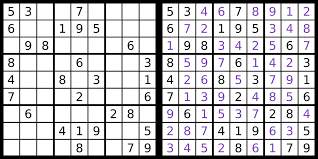Sudoku: A Foundation to My Obsession
“Ok so, a “6” can’t go there, so it must go in this column… but which box? But that doesn’t matter because ‘6’ has to go in this row of this square anyhow and so then… ‘3’ goes underneath! Yes, I got it!”
Make no mistake—in my family, Friday night Sudoku is an all out war between me and my parents. Glasses filled with coffee sit on the table to keep us mentally sharp in the heat of the battle. Pencil tips snap frequently from furious scribbling; eraser shavings pile up in a mountain to the side; heads are scratched occasionally; hairs are pulled out in frustration. We all start at the same time and see who will solve it first and be called the “Friday night champ.”
After my grandfather introduced me to Sudoku, it has been a long-time passion of mine. At first, I was confused as to how he could fill a 9 x 9 grid with numbers, given only a handful of clues and numbers (2-3).
“Aren’t there many solutions to the puzzle?” I frequently asked him.
“No. You need to look beyond the obvious and recognize the subtle patterns—not to mention some guessing and checking,” he responded.
That day, my grandfather bought two copies of a Sudoku puzzle book: one for him and one for myself. We worked on them together, where I frequently asked for his help. I studied his approaches and techniques carefully, not missing a single step. We spent hours after hours on determining a single digit, accompanied by the materialization of the other digits in mere seconds. I soon realized that it wasn’t the number of numerals that were given that made the puzzle easy or hard to solve—it was which numerals were given that made the key difference. I got faster and better with every puzzle I was given, but it was never enough to quench my thirst!
From there, I dived deeper into more complicated Sudoku problems that were almost enough to make me acknowledge defeat and look at the answer. At times, the thrill that came from independently solving a Sudoku puzzle from the “Impossible” section was indescribable: it made you seem like you’re actually smart. It did demand one quality from the puzzler: patience. Sudoku is defined as “a puzzle in which players insert the numbers one to nine into a grid consisting of nine squares subdivided into a further nine smaller squares in such a way that every number appears once in each horizontal line, vertical line, and square” according to Oxford Languages, but no, no, no—at its most basic level, Sudoku is the art of learning how to take risks when necessary and knowing how to make mistakes at times (not intentionally, of course).
With my grandfather’s teachings, I have become no ordinary puzzler—I’m a “Sudokuaholic.”

Enjoy Reading This Article?
Here are some more articles you might like to read next: